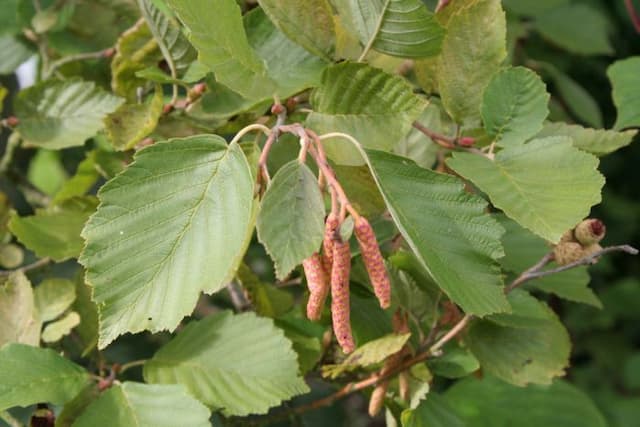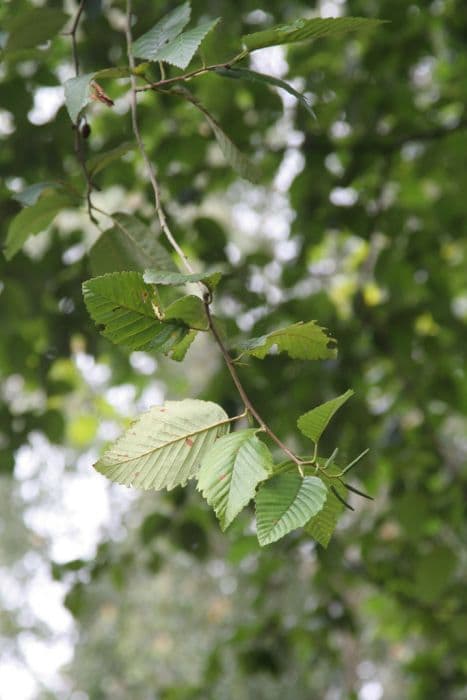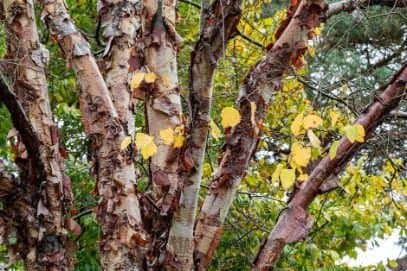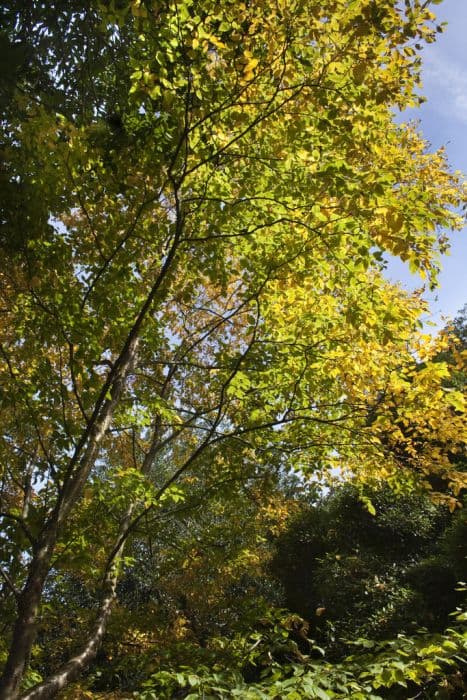Common hornbeam 'Pendula' Carpinus betulus 'Pendula'

ABOUT
'Pendula' is a slow-growing, deciduous, weeping tree to 6m tall with a dense, spreading crown. Its ovate, serrated, prominently veined leaves turn yellow and orange in the autumn
About this plant
 Names
NamesFamily
Betulaceae.
Synonyms
Weeping European Hornbeam, Weeping Common Hornbeam, Pendulous European Hornbeam.
Common names
Carpinus betulus 'Pendula'.
 Characteristics
CharacteristicsLife cycle
Perennials
Foliage type
Deciduous
Color of leaves
Green
Height
15 feet (4.57 meters)
Spread
13 feet (3.96 meters)
Plant type
Tree
Hardiness zones
4-8
Native area
Europe
Benefits
 General Benefits
General Benefits- Ornamental Value: Carpinus betulus 'Pendula', also known as the Weeping Hornbeam, has a distinct cascading form that adds aesthetic appeal to landscapes.
- Shade Provider: The dense foliage of the Weeping Hornbeam makes it an effective shade tree in gardens and parks.
- Wildlife Habitat: The tree can offer habitat and food for birds and other wildlife, contributing to local biodiversity.
- Soil Stabilization: With its robust root system, it helps prevent soil erosion particularly on slopes or banks.
- Durable Wood: The hardwood is valued for its strength and resistance, useful in carpentry and for making tools.
- Seasonal Interest: It boasts attractive green foliage in spring and summer, turning to a golden hue in autumn.
- Low Maintenance: Once established, it requires minimal care and is relatively low maintenance compared to other ornamental trees.
- Urban Tolerant: It is tolerant of urban pollution and can thrive in city environments, making it suitable for urban landscaping.
- Sound Barrier: The dense growth can act as a natural sound barrier, helping to reduce noise pollution.
- Privacy Screen: It can be used as a living screen or hedge to provide privacy in residential areas.
- Drought Resistance: It can withstand periods of drought once mature, making it a resilient choice for various climates.
- Tolerates Pruning: The tree responds well to pruning, allowing for control of its shape and size.
 Medical Properties
Medical PropertiesThis plant is not used for medical purposes.
 Air-purifying Qualities
Air-purifying QualitiesThis plant is not specifically known for air purifying qualities.
 Other Uses
Other Uses- The wood of Carpinus betulus, commonly known as European hornbeam, is very hard and has been historically used for woodworking, especially for carving detailed sculptures and intricate pieces due to its fine grain.
- European hornbeam's dense and even-burning wood makes it an excellent choice for fuelwood and charcoal production, which is especially valued for forging and blacksmithing tasks.
- In landscaping, the weeping variety of European hornbeam can be used to create a natural privacy screen due to its dense foliage and elegant, drooping branches.
- The leaves of the European hornbeam can be used as a natural dye, providing a range of colors from yellow to green, depending on the mordant used.
- Its flexible yet strong wood makes European hornbeam a suitable material for making tool handles, including hammers, axes, and spades that require sturdy grips.
- The wood is also favored for constructing wind instruments like woodwinds, where the density of the wood can contribute to the quality of the sound produced.
- European hornbeam can play a role in soil stabilization and erosion control due to its extensive root system, making it a practical choice for planting in slopes and areas prone to soil displacement.
- Artisans have used hornbeam wood for creating detailed inlays and marquetry work in fine furniture, thanks to its subtle color variations and workability.
- The tree's canopy offers a cool, shaded area that can be used for outdoor educational spaces, providing a comfortable learning environment during warmer months.
- European hornbeam branches, being both strong and flexible, have been used in traditional construction for roof framing, particularly in rural architecture that utilizes natural materials.
Interesting Facts
 Feng Shui
Feng ShuiThe Weeping Hornbeam is not used in Feng Shui practice.
 Zodiac Sign Compitability
Zodiac Sign CompitabilityThe Weeping Hornbeam is not used in astrology practice.
 Plant Symbolism
Plant Symbolism- Resilience and Toughness: Carpinus betulus 'Pendula', commonly known as Weeping Hornbeam, has a sturdy trunk and flexible branches, symbolizing the ability to endure and remain steadfast in the face of adversity.
- Adaptability: This tree is known for its ability to adapt to different soil types and environments, representing the resilience and flexibility required to thrive in various circumstances.
- Longevity: With its potential to live for a very long time, the Weeping Hornbeam embodies endurance, continuity, and the passage of time.
- Patience: It grows slowly and steadily, symbolizing the quality of patience and the importance of growth at one's own pace.
- Strength: The wood of the Weeping Hornbeam is extremely hard and dense, often used to make strong tools, signifying physical and inner strength.
- Protection: The dense canopy offers shelter and protection to the wildlife, which can be seen as a symbol for providing care and safeguarding others.
 Water
WaterThe Weeping Hornbeam should be watered deeply and thoroughly, allowing the soil to be well-saturated. It's important to ensure that water reaches deep into the root zone. Watering frequency depends on the climate and soil conditions but generally once a week is adequate, increasing to twice a week during hot, dry periods. Approximately 1 to 1.5 gallons should be sufficient each time for a young tree, adjusting the amount as the tree grows and depending on the weather. It's essential to reduce watering in the fall to prepare the tree for winter dormancy.
 Light
LightThe Weeping Hornbeam thrives best in full sun to partial shade. The ideal spot would allow for at least 4 to 6 hours of direct sunlight daily, but the tree can also tolerate some shade. Avoid locations where the tree is in deep shadow to ensure healthy growth.
 Temperature
TemperatureThe Weeping Hornbeam can tolerate a range of temperatures; however, ideal growing conditions are between 60°F and 70°F. It is able to withstand a maximum temperature of about 80°F to 90°F and a minimum temperature down to about -20°F to -30°F. The plant is quite hardy and can survive through typical winters in temperate climates.
 Pruning
PruningThe Weeping Hornbeam should be pruned to maintain its shape and remove any dead or diseased wood. The best time for pruning is in late winter to early spring, before the new growth starts. Pruning may also be necessary to prevent the tree's pendulous branches from touching the ground. Thinning out the canopy every few years will help maintain the health and appearance of the tree.
 Cleaning
CleaningAs needed
 Soil
SoilFor the European Weeping Hornbeam, a well-draining, fertile loam-based soil with a pH of 5.5 to 7.5 is ideal. Amend the soil with organic matter and ensure adequate drainage to prevent waterlogging.
 Repotting
RepottingEuropean Weeping Hornbeams are typically outdoor trees and do not require frequent repotting; instead, focus on replacing the topsoil annually or as needed to replenish nutrients.
 Humidity & Misting
Humidity & MistingThe European Weeping Hornbeam is adaptable and does not require specific humidity conditions, thriving in the natural outdoor humidity levels of its environment.
 Suitable locations
Suitable locationsIndoor
Growing indoors is not advised for the European Weeping Hornbeam, as it is a large outdoor tree.
Outdoor
Plant in well-drained soil, full sun to partial shade, and water regularly.
Hardiness zone
4-8 USDA
 Life cycle
Life cycleCarpinus betulus 'Pendula', also known as Weeping European Hornbeam, begins its life cycle as a seed, which upon finding suitable moist soil conditions will germinate in spring. The seedling grows into a young sapling, establishing a strong root system and beginning to exhibit its characteristic weeping habit. As it matures into an adult tree, it develops a dense canopy of pendulous branches with serrated, green leaves; this stage may last for several decades as the tree grows slowly. Seasonally, the Weeping European Hornbeam produces catkins in early spring followed by winged nutlets that disseminate for reproduction. In the fall, its leaves turn to shades of yellow and orange before shedding, marking a period of dormancy during the winter months. Ultimately, after a long lifespan that can exceed a century, the tree will enter senescence, where growth slows and the tree eventually dies, returning nutrients to the soil and completing the cycle.
 Propogation
PropogationPropogation time
Early spring
The Carpinus betulus 'Pendula', commonly known as the Weeping Hornbeam, is typically propagated through grafting, which is the most popular method due to its reliability in maintaining the weeping form of this specific cultivar. Grafting is usually performed in late winter to early spring before the sap starts flowing. To graft, a scion, which is a piece of a branch from a desired weeping hornbeam, with several buds, is cut and then joined to the rootstock, which is often a seedling or a young tree of a standard Carpinus betulus. The cut on both the scion and the rootstock must be compatible for the graft to take successfully. This can be done with a slanted cut, usually measuring around 1 to 2 inches (2.5 to 5 cm) in length, which is then bound together with grafting tape or similar material to hold the union secure until the graft has taken and the tissues have fused, typically in a few weeks to several months.









